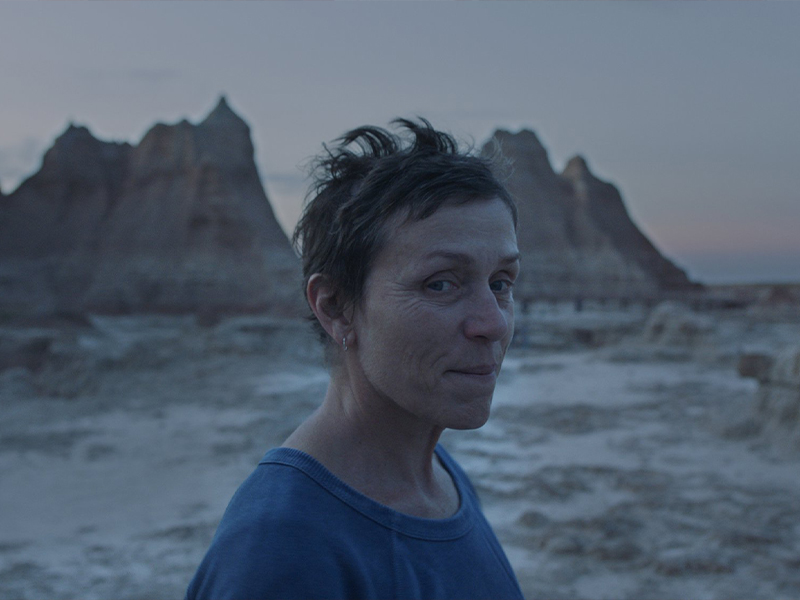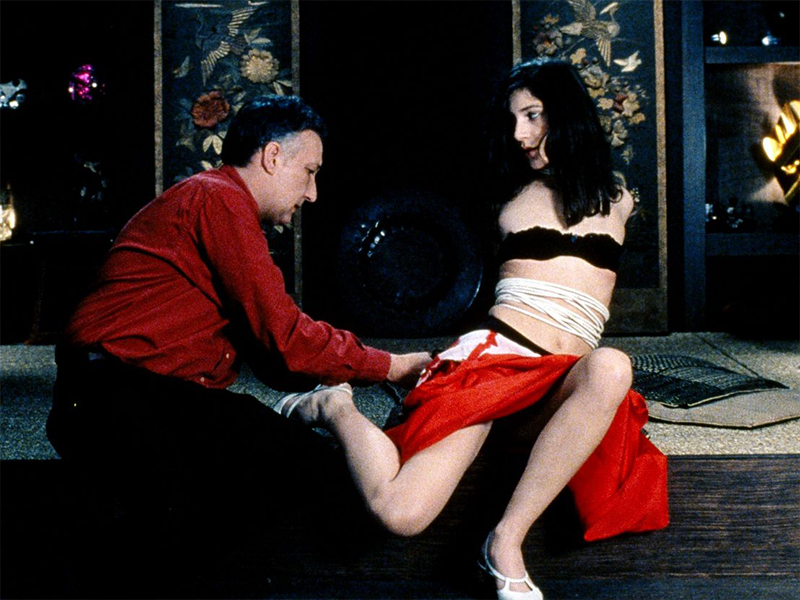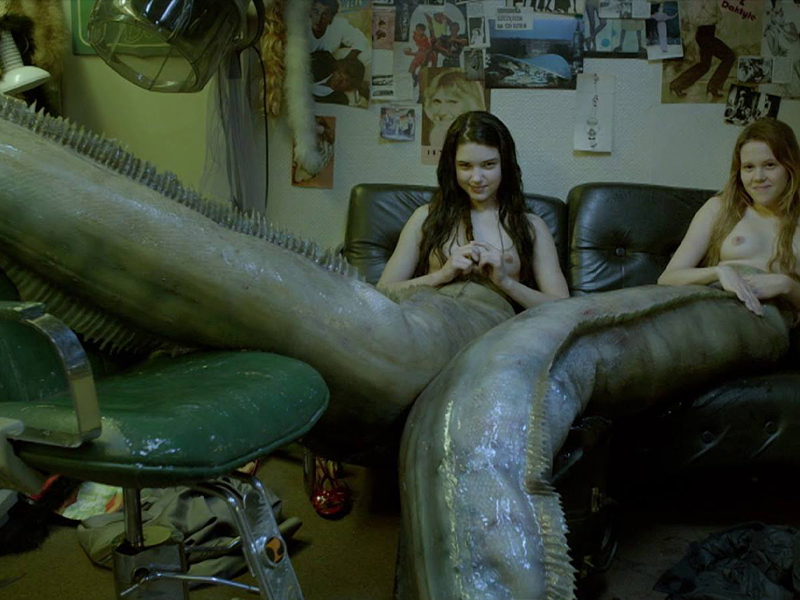Seven contemporary films by female directors
I feel that the habit of offering flowers and buying the traditional trinkets in March has become rather a social obligation and less an act of true celebration of women; we’re far from understanding the real needs of women everywhere, so then these vulgar gifts only manage to add insult to injury. In cinema, surely, changes started to happen, albeit things seem to turn around in slow motion – just the other day, Chloe Zhao was distinguished with two Golden Globes for her film Nomadland (Best Director & Best Motion Picture – Drama), following the Golden Lion won in Venice. The fact that she is the second woman to receive the award for directing, after Barbra Streisand, in 1984, shows only how blind the voting members can be; a film directed by a woman barely makes it within range. I’m not here to play the vigilante, it’s pretty clear that women will never do great in this regard, nor that we will ever be able to even simulate the idea of equal opportunities; that being so, I’m aware that the list I put together will not make such a difference. For each film that stems from a real, feminine experience, ten more arise that hinder it with harmful stereotypes, and further sexualize/objectify the female characters (and, therefore, cancel out all its efforts); and besides, there are so many male viewers who don’t even notice this aspect – and to whom I would offer, as a remedy for their ignorance, a film by Catherine Breillat, a French filmmaker with a scandalous reputation who destroys the mythology built around female sexuality.
A dossier that celebrates female filmmakers everywhere is Girls on Film, doing so chronologically, and thus paving the way for the history of women’s cinema. In a way, this column featured in Acoperisul de Sticla (ie. Romanian online publication) showed another side of the film history as we know it, which usually overlooked female filmmakers or made too little room for them. The list below may be accused of partisanship, and rightly so (here is, for example, a more extensive reading on the subject, which reminds me there’s a need for such listings in Romanian, as well). Why these titles in particular and not others? My pick includes seven contemporary films portraying female characters from meteoric perspectives, a constant concern of mine: what does it mean to be a woman in Zambia, where the government goes out on witch hunts? But in Mexico, how does a maid see life in a luxury hotel? With Nomadland, the choice came naturally: Nomadland is without a doubt the American film of the year, which goes into the experience of living a nomad life for a single woman who, no matter how hard she tries to blend in, can no longer take root.
I Am Not a Witch (dir. Rungano Nyoni, 2017)

In I Am Not a Witch, the Zambian-Welsh director Rungano Nyoni’s film debut, an orphaned girl arrives in a village, but doesn’t really speak; local authorities identify her silence with black magic, blaming her for all the local scourges (either that the water has changed since she arrived, or that buckets slip from women’s hands when they meet eyes with her, or that men dream that the girl is torturing them). All this nonsense leads to a real investigation and a witch doctor is called on; he gets a chicken, cuts off its head, and if the chicken dies outside the circle it ran around before, it’s proof that the girl is a witch. Anyway, her self-appointed caretaker, a sleazy clown serving the state, in charge of sorting out the witches, takes her to some sort of chanting park, a tourist corral that financially supports the local mythology and also puts old women in forced labor, who from time to time receive small gifts from their daughters that help them get in touch with the real world (wigs with the mangled names of Rihanna, Beyonce, etc.). What adds to the irony is the “umbilical cord” metaphor – a white ribbon attached to their back skin, like a chain, which limits their going distance. The girl (who is given the name Shula, meaning “uprooted”) must make a choice between this world, so joining the matriarchy of resigned witches, and becoming a goat. In fact, the abuse in this world doesn’t offer you any choice as a woman – you are thrown around at the authorities’ will (either to make it rain, or to find out who stole from whom). The director’s background (born in Zambia, living in Wales) has a somewhat influence on her debut; it’s a mixture between local Zambian mythology, based on superstition and magic, and a detached, dramedy-like way of looking at the world, which is more related to European cinema (wide, beautiful, carefully crafted shots). Thus, the film bets on emphasizing the stupidity of the “local sharks”, their indifference to the girl’s education and inner world, where magical realism slips in (a funnel through which she manages to hear the school lessons from a great distance).
Nomadland (dir. Chloé Zhao, 2020)

In Nomadland, dinosaurs are depicted either as statues in amusement parks or as nomads, the last remainders of the “American dream”: there are so many people fed up with capitalist life, who have lost everything due to mortgages or debts, the victims of the 2000s recession. They are beings without a permanent shelter, only a trailer or a caravan and a neverending discovery; Zhao doesn’t make out of nomad life an ideal experience, but shows the hardship one has to bear, especially as a single woman. Fern (Frances McDormand, probably her best role yet) is one of the few fictional characters; most of the non-professionals who appear in front of the camera to share a piece of their story are real nomads, met by Zhao during her research. The fact that Nomadland is a doc-fiction is less important, as is the fact that it doesn’t delve in the protagonist’s background; the film shows that it’s this very embracing of the unknown that makes nomads’ life so simple and that, in the solitude of their tribe, only they understand what it means to leave your roots behind and, in turn, pursue a contemplative life, free of material possessions, where whatever you give finds a way back to yourself. Zhao shows this very nuanced lifestyle – they are lonely or old people waiting for their end in their caravans, far from any family, friends or loved ones.
Everyone Else (dir. Maren Ade, 2009)

Before the already-canonized Toni Erdmann (2016), by the German director Maren Ade, there was Everyone Else; same as Toni Erdmann, the latter is based on all sorts of adult games. The characters are a couple on holiday in Sardinia, Gitti (Birgit Minichmayr) and Chris (Lars Eidinger); one can notice from the very start that they both have a very definite safe zone which keeps the crystal globe in one piece, a bunch of childish kinks like putting make-up on each other or inventing a character from a piece of ginger, Schnappi, a mascot with a small penis. Outside their games and sex life, it’s clear that there are some frustrations hidden under the rug somewhere (Gitti thinks she’s not smart or feminine enough for Chris, and he’s afraid he’s too boring compared to her naughty nature; he is the good architect who guards his mother’s trinkets, she is wild and impulsive; it’s a matter of masculinity vs. femininity, where none of them feels that can stand out). The film is a superb and completely unbiased x-ray of their relationship, of their lack of real communication. The harmony goes into ruin when they find their perfect equivalents (an architect that Chris keeps avoiding while on the island, and his pregnant wife); mirroring each other, all their flaws start to become obvious. In his video essay Love and Irony, Kevin B. Lee analyzes a simple sequence from the film – Chris swaying his body over his mother’s trinkets. In this scene, Lee actually points out to an extremely nuanced facet of their relationship and to the way Ade sets the camera on her characters: it’s an absolute delight because he talks about two types of non-verbal love expression (lying on the floor, Chris wants to make Gitti laugh, and Gitti responds with a warm, forgiving look). None of them knows how to tell each other what they really feel, and when they do, it comes out into bits and pieces, all wrong, hilarious.
The Souvenir (dir. Joanna Hogg, 2019)

It’s the early ’80s in the UK. Julie (Honor Swinton Byrne) is a film directing student, where she wants to do a doc-fiction about a 16-year-old boy, overly attached to his mother, who lives on the other half of the map, in Sunderland; the film also intends to document the lives of the local fishermen and their boats, but it’s far from her experience. Colleagues and teachers criticize her desire to make films about the lower-class, when she still gets financial support from her parents. “I want to see what’s also happening outside my bubble”, she says at one point. “Why wouldn’t it be real since it’s inspired by the lives of the people who live there?” Anyway, I began with this observation because The Souvenir is equally an autofiction (so Hogg translates her sublime experience onto the screen, an unusual love affair with a drug addict) and an instrument of self-questioning and memory, because it establishes from the very beginning the type of relation that exists between Hogg and her view on cinema. The story is far from being a conventional one: at a party, Julie meets the dandy misanthrope Anthony (Tom Burke). They gradually exchange all sorts of Victorian courtesies (he invites her to a royal picnic, to the museum, to a tea party, plays her classical music and walks everywhere in his velvet robe, with an air of pompousness); intellectually and financially, they consume every novelty of their time together, and Anthony suddenly moves to Julie, where each of them negotiates their own comfort. The same bourgeois fetishes that hold them together separate them from the rest of the world – Julie rarely goes to college now, she’s completely stuck in this blank space of ideas, and Anthony is a financial parasite who dries up his mother-in-law (Tilda Swinton, wonderful in this role) to feed his coke use.
La Camarista (dir. Lila Avilés, 2019)

La Camarista / The Chambermaid focuses on some social categories that movies usually give skip to (the working class who make sure that luxury hotels keep up with their standards, people who knock on your door discreetly, while watching shows on Animal Planet, to bring you toilet paper), invisible people who do not have the luxury of existential problems, but carry a heavy load on their shoulders. Evelia (Gabriela Cartol) is one of them; other directors might have chosen to create a private-public profile of the protagonist’s life (by showing her in the privacy of her own home at least once), but Avilés keeps her character cloistered in the hotel, rarely talking on the phone with her son’s nanny. Eve works every job and does everything possible in order to climb in the chambermaids’ hierarchy (the apartments on the upper floors are the most luxurious, and so, the most coveted; whoever gets to take over an entire floor as such wins the respect of their colleagues) and to participate in the sharing of lost & found objects (at the end of the month, they organize some sort of lottery where dresses and possessions left by hotel guests in their rooms are put up for grabs). Plus, the extravagances of the guests – at one point, Eve is summoned to watch after a baby so the mother can take a shower during this time. Eve is looking for a way out, but all the doors close one by one, and the job becomes exhausting at one point (the dress she wanted goes to someone else, the GED class she began to take is shut down, she even works overtime when covering for her colleagues). There’s something of Jeanne Dielman in Evelia’s character, though the latter rebels in silence – what kind of life is that if your only joy is to contemplate a window lying on someone else’s bed?
Romance X (dir. Catherine Breillat, 1999)

Romance X is Catherine Breillat’s best-known film – and a very approachable one: it’s the story of Marie (Caroline Ducey), who, after being sexually rejected every night by her boyfriend, Paul (Sagamore Stevenin), ends up unleashing her erotic buildup with all sorts of strangers (one is played by Rocco Siffredi, another is the principal of her own school where she teaches French, and another she picks up on the street); her erotic quest doesn’t bring her satisfaction or remorse, she seems to initiate it out of revenge for her boyfriend’s indolence, then continues out of a self-destructive routine. It’s not clear whether or not Marie is a nymphomaniac, but this detail is far less important: it’s not the act itself that interests her, but the thought of it and the preparation. Romance X is a study of the colors associated with libido (the couple’s bedroom is of a hospital white, where all sexual attempts come to a stop on account of all sorts of whims, like cotton allergy or TV shows; the principal’s playroom, on the other hand, is filled with wood and metal, somewhere at the intersection of sobriety and masochism); the misleading title may suggest a happy ending, but it’s actually a manifesto against boredom and sexual conformity: Marie literally blows up the building where she lives with Paul and starts over.
The Lure (dir. Agnieszka Smoczyńska, 2015)

In The Lure, the mermaid horror musical set in communist Poland (what more extravagant combination than this one?), Silver and Golden are two sea creatures co-opted as backing vocals and striptease by a local band (the term “co-opted” may be too elegant, since they’re actually exploited for their exoticism); every night, they sing and dance in this local joint. As in Smoczynska’s most recent film, Fuga (2018), the cinematography is fluid and hyperstilized, in shades of emerald green; the magical realism in The Lure is contagious – if you’re not enchanted by the songs of the nymphs, which if they fall in love and do not kill their human partners, they turn into dust, then maybe it will be the impressive anachronistic choreography through the remnants of both capitalism and communism that will lead to this effect. By a lot of standards out there, The Lure is completely outrageous and disgusting even, because it shows an off-limits fantasy, where the conventions of “normality” change along the way (one of the mermaids gives up its tail, for example, and Smoczynska shows the entire surgical intervention; the next day, she is almost healed and ready to have sex with her human lover).
Journalist and film critic, with a master's degree in film critics. Collaborates with Scena9, Acoperișul de Sticlă, FILM and FILM Menu magazines. For Films in Frame, she brings the monthly top of films and writes the monthly editorial Panorama, published on a Thursday. In her spare time, she retires in the woods where she pictures other possible lives and flying foxes.
